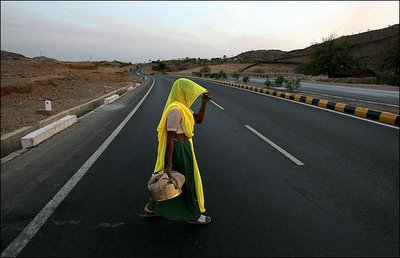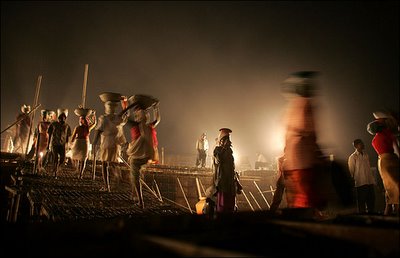India Builds the Futurist Highway

[Image: “A woman crossing a stretch of India’s improved national highway system in a village in the northern state of Rajasthan.” Tyler Hicks/New York Times].
More Asian highway news: “The Indian government has begun a 15-year project to widen and pave some 40,000 miles of narrow, decrepit national highways, with the first leg, budgeted at $6.25 billion, to be largely complete by next year. It amounts to the most ambitious infrastructure project since independence in 1947 and the British building of the subcontinent’s railway network the century before.”
As the New York Times opines: “The effort echoes the United States’ construction of its national highway system in the 1920’s and 1950’s. The arteries paved across America fueled commerce and development, fed a nation’s auto obsession and created suburbs. They also displaced communities and helped sap mass transit and deplete inner cities.”
India’s automotive modernization, however, allows the New York Times this quick throwaway line: “Goddess versus man, superstition versus progress, the people versus the state – mile by mile, India is struggling to modernize its national highway system, and in the process, itself.”
A part of me wonders if the article’s author only wanted to cover the story in order to write that sentence...

[Image: “Migrant workers carrying cement at night to fill a section of a bridge under construction west of Aurangabad, in the state of Bihar.” Tyler Hicks/New York Times].
“At its heart,” the author continues, “the redone highway is about grafting Western notions of speed and efficiency onto a civilization that has always taken the long view.”
Always?
In any case, as the monolithic abstract surfaces of desert highways begin to coil and stretch themselves over the often rugged Indian topography, the mountains and swamps, passing through collapsing cities on shores, perhaps we will see a new kind of Indian Futurism arise, taking over from the outdated and Italianate F.T. Marinetti and Antonio Sant’Elia, an art of speed and travel and roadside architectural abstraction; or perhaps the fresh start of a counter-Bollywood, a traveling, digital, hyper-realist cinema that maps the outer edges of this newly autobahn’d Indian subcontinent with hand-held cameras and cheap cars, filmmakers traveling together at 90mph. DIY psychovideography, roadborne.
What, then, would happen when all this links up with the Asian Highway Project? When our possible future routes stretch from Finland to Tokyo, via Tehran and Outer Mongolia? What then? What future arts and structures will we make then?
A BLDGBLOG Guide to the Asian Highway Project. Interested funders, be in touch.





Comments are moderated.
If it's not spam, it will appear here shortly!
I've heard some preety lame comments in my life but this article takes the cake. What was all that "Goddess vs man,..." crap? What Goddess? And why the clash? Why should our superstitions(if any) come in the way of building a highway. Even the poorest of the poor know it's going to generate employment. Why would the people oppose the highway? What relation exists between religion and development?Does the author know anything about the country he's talking about? The authors' probably one of those people who call up an Indian call centre and then expect to be told they're speaking to someone with a 'Hindu' sounding name. This kind of ignorance isn't only hard to find, it's also hard to develop.
I doubt you read the article. Your ignorance is apparent, and thus your comments are hard to take seriously. Read the article. December 5, 2005: NY Times.
Please just read the article, read about megaprojects, read about India, read about displacement and eminent domain, and then make comments.
This highway is certainly a subject of pride for Indians, but it has also been a subject of lamentation of the end of a definitive era of slow, tightknit, deeprooted village life. This binary moment of juggling the old and the new, and coming up with a balance deserves a spotlight that I think Amy Waldman was trying to get at.
She was as perceptive as anyone can be. Regardless of religious or national background. Despite its benefits, displacement from ancestral roots is no fun.
Deepa,
The concept of binary cultures really does not fit the Indian subcontinent. The region (Rajasthan) in the photos was under hellenistic rule under Alexander in 300 BC, followed by the Buddhist Mauryans, Kanishka (Chinese), the Indo-Scythians, the Indo-Persians, the Mughals (descended from the Mongols), the British (not really local cheiftains, were they?), and under the Republic of India since 1947.
The local culture you mention is an amalgamation of many millenia of contact with the outside world which came about through highways and ports.
Eminent domain and displacement are definitely important questions. But, everything in the world has pros and cons. I can understand the negatives of, say adding 10 more lanes to the New Jersey Turnpike. But, where does the tradeoff come up in a nation with the level of infrastructure that India has?
The following part of the article-“Goddess versus man, superstition versus progress, the people versus the state – mile by mile, India is struggling to modernize its national highway system, and in the process, itself.”......is objectionable for any Indian.Superstition and religion and development are no where connected and I find it highly offendable and surprised to see it published.-Sandeep.P Pune
Latecomer though I am to this post, I can only observe that these projects are only signatures of India's growing militarism. Oh Sure! There are benefits, logistical benefits...rapid transit of people, goods, services and warmachines. What this highway system will do for India is to expose her womb for the Western warmachine - after all, did not the autobahns of Nazi Germany facilitate the Allied invasion of the Ruhr? Conversely, did not the lack of precisely such a road (and rail) network impede the dramatic advance of the Wehrmacht in Russia?
I wonder if there is a way to conceptualize, design and build a highways system that impedes the progress of the warmachine?
And while on the subject, have you ever seem the Dharavi slums while flying into Bombay? Even better, have you ever walked through the Dharavi slums? Now imagine the US 3rd Infantry Division (allegedly the most technologically networked division) trying to fight an urban battle there!!!! They will get massacred! And that, in essence, is the nature of the so-called 'Asian' cities! No blocks to neatly mark off and target, no roads perpendicular from where enfilading fire angles can be set up. If war and the battle is a site of chaos then these slums are the post-modern battlespaces!
Cheers!
Post a Comment